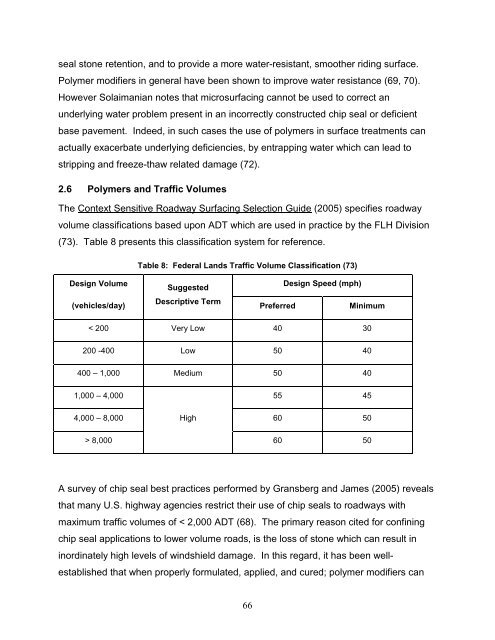Using Polymer Modified Asphalt Emulsions in Surface Treatments A ...
Using Polymer Modified Asphalt Emulsions in Surface Treatments A ...
Using Polymer Modified Asphalt Emulsions in Surface Treatments A ...
You also want an ePaper? Increase the reach of your titles
YUMPU automatically turns print PDFs into web optimized ePapers that Google loves.
seal stone retention, and to provide a more water-resistant, smoother rid<strong>in</strong>g surface.<br />
<strong>Polymer</strong> modifiers <strong>in</strong> general have been shown to improve water resistance (69, 70).<br />
However Solaimanian notes that microsurfac<strong>in</strong>g cannot be used to correct an<br />
underly<strong>in</strong>g water problem present <strong>in</strong> an <strong>in</strong>correctly constructed chip seal or deficient<br />
base pavement. Indeed, <strong>in</strong> such cases the use of polymers <strong>in</strong> surface treatments can<br />
actually exacerbate underly<strong>in</strong>g deficiencies, by entrapp<strong>in</strong>g water which can lead to<br />
stripp<strong>in</strong>g and freeze-thaw related damage (72).<br />
2.6 <strong>Polymer</strong>s and Traffic Volumes<br />
The Context Sensitive Roadway Surfac<strong>in</strong>g Selection Guide (2005) specifies roadway<br />
volume classifications based upon ADT which are used <strong>in</strong> practice by the FLH Division<br />
(73). Table 8 presents this classification system for reference.<br />
Table 8: Federal Lands Traffic Volume Classification (73)<br />
Design Volume<br />
(vehicles/day)<br />
Suggested<br />
Descriptive Term<br />
Preferred<br />
Design Speed (mph)<br />
M<strong>in</strong>imum<br />
< 200 Very Low 40 30<br />
200 -400 Low 50 40<br />
400 – 1,000 Medium 50 40<br />
1,000 – 4,000<br />
55 45<br />
4,000 – 8,000 High<br />
60 50<br />
> 8,000 60 50<br />
A survey of chip seal best practices performed by Gransberg and James (2005) reveals<br />
that many U.S. highway agencies restrict their use of chip seals to roadways with<br />
maximum traffic volumes of < 2,000 ADT (68). The primary reason cited for conf<strong>in</strong><strong>in</strong>g<br />
chip seal applications to lower volume roads, is the loss of stone which can result <strong>in</strong><br />
<strong>in</strong>ord<strong>in</strong>ately high levels of w<strong>in</strong>dshield damage. In this regard, it has been wellestablished<br />
that when properly formulated, applied, and cured; polymer modifiers can<br />
66
















